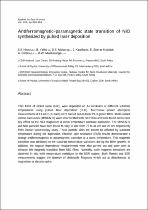 ResearchSpace
ResearchSpace
Antiferromagnetic–paramagnetic state transition of NiO synthesized by pulsed laser deposition
JavaScript is disabled for your browser. Some features of this site may not work without it.
- ResearchSpace
- →
- Research Publications/Outputs
- →
- Journal Articles
- →
- View Item
| dc.contributor.author |
Nkosi, SS

|
|
| dc.contributor.author |
Yalisi, B

|
|
| dc.contributor.author |
Motaung, DE

|
|
| dc.contributor.author |
Keartland, J

|
|
| dc.contributor.author |
Sideras-Haddad, E

|
|
| dc.contributor.author |
Forbes, A

|
|
| dc.contributor.author |
Mwakikunga, Bonex W

|
|
| dc.date.accessioned | 2014-07-30T09:19:41Z | |
| dc.date.available | 2014-07-30T09:19:41Z | |
| dc.date.issued | 2013-01 | |
| dc.identifier.citation | Nkosi, S.S, Yalisi, B, Motaung, D.E, Keartland, J, Sideras-Haddad, E, Forbes, A and Mwakikunga, B.W. 2013. Antiferromagnetic–paramagnetic state transition of NiO synthesized by pulsed laser deposition. Applied Surface Science, vol. 265, pp 860-864 | en_US |
| dc.identifier.issn | 0169-4332 | |
| dc.identifier.uri | https://doi.org/10.1016/j.apsusc.2012.11.134 | |
| dc.identifier.uri | http://hdl.handle.net/10204/7540 | |
| dc.identifier.uri | https://www.sciencedirect.com/science/article/pii/S0169433212021095 | |
| dc.description | Copyright: 2013 Elsevier. This is an ABSTRACT ONLY. The definitive version is published in Applied Surface Science, vol. 265, pp 860-864 | en_US |
| dc.description.abstract | Thin films of nickel oxide (NiO) were deposited on Al substrates at different substrate temperatures using pulsed laser deposition (PLD). Microwave power absorption measurements at 9.4 GHz (X-band) were carried out on these PLD grown films. Multi-walled carbon nano-tubes (MWCNTs) were incorporated with NiO films and were found not to have any effect on the NiO magnetism at room temperature substrate deposition. The MWCNTs and NiO particles have been found to vary in size from 73 to 44 nm and 20 nm respectively from Raman spectroscopy study. These particle sizes are known be affected by substrate temperature during the deposition. Electron spin resonance (ESR) results demonstrated a strange antiferromagnetic to paramagnetic transition at a room temperature. This magnetic transition was attributed to the substrate temperature variations during the films growth. In addition, the angular dependence measurements were also carried out and were seen to enhance this magnetic transition from NiO films. Normally, such magnetic transitions are observed in situ with temperature variations in the ESR system. Both Raman and ESR measurements suggest the absence of detectable Magnons which act as disturbances to magnetism or electron spins. | en_US |
| dc.language.iso | en | en_US |
| dc.publisher | Elsevier | en_US |
| dc.relation.ispartofseries | Workflow;12843 | |
| dc.subject | Antiferromagnetic | en_US |
| dc.subject | NiO | en_US |
| dc.subject | Paramagnetic | en_US |
| dc.subject | Pulsed laser deposition | en_US |
| dc.subject | Nickel oxide | en_US |
| dc.subject | PLD | en_US |
| dc.subject | Multi-walled carbon nano-tubes | en_US |
| dc.subject | MWCNT | en_US |
| dc.title | Antiferromagnetic–paramagnetic state transition of NiO synthesized by pulsed laser deposition | en_US |
| dc.type | Article | en_US |
| dc.identifier.apacitation | Nkosi, S., Yalisi, B., Motaung, D., Keartland, J., Sideras-Haddad, E., Forbes, A., & Mwakikunga, B. W. (2013). Antiferromagnetic–paramagnetic state transition of NiO synthesized by pulsed laser deposition. http://hdl.handle.net/10204/7540 | en_ZA |
| dc.identifier.chicagocitation | Nkosi, SS, B Yalisi, DE Motaung, J Keartland, E Sideras-Haddad, A Forbes, and Bonex W Mwakikunga "Antiferromagnetic–paramagnetic state transition of NiO synthesized by pulsed laser deposition." (2013) http://hdl.handle.net/10204/7540 | en_ZA |
| dc.identifier.vancouvercitation | Nkosi S, Yalisi B, Motaung D, Keartland J, Sideras-Haddad E, Forbes A, et al. Antiferromagnetic–paramagnetic state transition of NiO synthesized by pulsed laser deposition. 2013; http://hdl.handle.net/10204/7540. | en_ZA |
| dc.identifier.ris | TY - Article AU - Nkosi, SS AU - Yalisi, B AU - Motaung, DE AU - Keartland, J AU - Sideras-Haddad, E AU - Forbes, A AU - Mwakikunga, Bonex W AB - Thin films of nickel oxide (NiO) were deposited on Al substrates at different substrate temperatures using pulsed laser deposition (PLD). Microwave power absorption measurements at 9.4 GHz (X-band) were carried out on these PLD grown films. Multi-walled carbon nano-tubes (MWCNTs) were incorporated with NiO films and were found not to have any effect on the NiO magnetism at room temperature substrate deposition. The MWCNTs and NiO particles have been found to vary in size from 73 to 44 nm and 20 nm respectively from Raman spectroscopy study. These particle sizes are known be affected by substrate temperature during the deposition. Electron spin resonance (ESR) results demonstrated a strange antiferromagnetic to paramagnetic transition at a room temperature. This magnetic transition was attributed to the substrate temperature variations during the films growth. In addition, the angular dependence measurements were also carried out and were seen to enhance this magnetic transition from NiO films. Normally, such magnetic transitions are observed in situ with temperature variations in the ESR system. Both Raman and ESR measurements suggest the absence of detectable Magnons which act as disturbances to magnetism or electron spins. DA - 2013-01 DB - ResearchSpace DP - CSIR KW - Antiferromagnetic KW - NiO KW - Paramagnetic KW - Pulsed laser deposition KW - Nickel oxide KW - PLD KW - Multi-walled carbon nano-tubes KW - MWCNT LK - https://researchspace.csir.co.za PY - 2013 SM - 0169-4332 T1 - Antiferromagnetic–paramagnetic state transition of NiO synthesized by pulsed laser deposition TI - Antiferromagnetic–paramagnetic state transition of NiO synthesized by pulsed laser deposition UR - http://hdl.handle.net/10204/7540 ER - | en_ZA |





